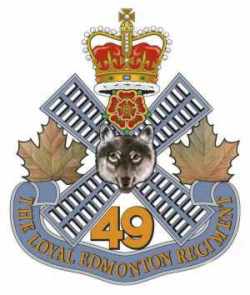|
Loyal Edmonton Regiment
The Loyal Edmonton Regiment (4th Battalion, Princess Patricia's Canadian Light Infantry), or L Edmn R, is a Primary Reserve infantry unit of the Canadian Armed Forces based in Edmonton, Alberta. The Loyal Edmonton Regiment is part of 3rd Canadian Division's 41 Canadian Brigade Group. They are colloquially known as "The Loyal Eddies".[1] Lineage
The Loyal Edmonton Regiment
PerpetuationsThe Great War
HistoryThe Great WarThe 49th Battalion (Edmonton Regiment), CEF was authorized on 7 November 1914 and embarked for Great Britain on 3 June 1915. It disembarked in France on 9 October 1915, where it fought as part of the 7th Infantry Brigade, 3rd Canadian Division in France and Flanders until the end of the war. The battalion disbanded on 15 September 1920.[2] The 51st Battalion (Edmonton), CEF was authorized on 7 November 1914 and embarked for Great Britain on 1 April 1916. There it provided reinforcements for the Canadian Corps in the field until 13 November 1916, when it was reorganized as a Garrison Duty Battalion. On 22 June 1916, its personnel were absorbed by the various regimental depots. The battalion disbanded on 15 September 1920.[2] The 63rd Battalion (Edmonton), CEF was authorized on 20 April 1915 and embarked for Great Britain on 22 April 1916. There it provided reinforcements for the Canadian Corps in the field until 7 July 1916, when its personnel were absorbed by the 9th Reserve Battalion, CEF. The battalion disbanded on 1 September 1917.[2]
Second World WarThe regiment mobilized The Edmonton Regiment, CASF for active service on 1 September 1939. It was redesignated as the 1st Battalion, The Edmonton Regiment, CASF on 7 November 1940; and as the 1st Battalion, The Loyal Edmonton Regiment on 7 July 1943. On 22 December 1939, it embarked for Great Britain. "D" Company participated in the expedition to the Norwegian island of Spitzbergen on 25 August 1941, and the battalion landed in Sicily on 10 July and Italy on 3 September 1943, as part of the 2nd Infantry Brigade, 1st Canadian Infantry Division. The unit landed in France on 15 March 1945 as part of Operation Goldflake, on its way to the Northwest Europe theatre of operations, in which it fought until the end of the war. The overseas battalion disbanded on 15 October 1945.[2]
On 1 June 1945, a second Active Force component of the regiment was mobilized for service in the Pacific theatre of operations, as under the 3rd Canadian Infantry Battalion (The Loyal Edmonton Regiment), CASF. The battalion disbanded on 1 November 1945.[2]
Post-War: Korea and NATOOn 4 May 1951, the regiment mobilized two temporary Active Force companies designated "E" and "F" Companies. "E" Company was reduced to nil strength when its personnel were incorporated into the 1st Canadian Infantry Battalion (later the 3rd Battalion, The Canadian Guards) for service in Germany with the North Atlantic Treaty Organization. It disbanded on 29 July 1953. "F" Company was initially used as a reinforcement pool for "E" Company. On 15 May 1952, it was reduced to nil strength, when its personnel were absorbed by the newly formed 2nd Canadian Infantry Battalion (later the 4th Battalion, The Canadian Guards) for service in Korea with the United Nations. "F" Company disbanded on 29 July 1953.[2] AfghanistanThe regiment contributed an aggregate of more than 20% of its authorized strength to the various Task Forces which served in Afghanistan between 2002 and 2014.[4] It suffered three dead and numerous injured during this war. Recent activitiesThe unit continues to carry out individual and small unit training locally and across Canada. The L EDMN R has continued to support NATO, UN, and Canadian domestic operations with multiple individual and group deployments. The regiment expanded to Yellowknife, Northwest Territories, with the establishment of C Company, The Loyal Edmonton Regiment, in August 2009.[5] In the summer of 2018, The Loyal Edmonton Regiment and Calgary Highlanders were tasked with standing up a mortar platoon that deployed to the Forward Presence Battle Group in Latvia in early 2020. This was the first Primary Reserve mortar platoon to deploy overseas.[6] Lineage chart
AlliancesBattle honoursIn the list below, battle honours in capitals were awarded for participation in large operations and campaigns, while those in lowercase indicate honours granted for more specific battles. Those battle honours followed by a "+" are emblazoned on the regimental colour.[2]
Great War
Second World War
War in Afghanistan
Victoria Cross recipientsRegimental badgeThe maple leaves symbolise service to Canada and the regiment's perpetuated units, the 51st and 63rd Battalions of the Canadian Expeditionary Force, and the crown, service to the Sovereign. The number 49 represents the service of the perpetuated unit, the 49th Battalion of the Canadian Expeditionary Force, and the windmill sails allude to the battlefields in Flanders on which the battalion fought in the First World War. The coyote's head commemorates "Lestock", a prairie coyote presented to the regiment as a mascot prior to the 49th Battalion's departure for overseas service in 1915. The red rose came from the badge of the former allied regiment The Loyal Regiment (North Lancashire) (now, through amalgamation, the Duke of Lancaster's Regiment). "THE LOYAL EDMONTON REGIMENT" is a form of the regimental title.[9] Loyal Edmonton Regiment Military MuseumThe Loyal Edmonton Regiment Military Museum is in Edmonton in the Prince of Wales Armouries Heritage Centre,[10] the building where the regiment was based from 1920 to 1965. The building also houses the City of Edmonton Archives[11] and the Telephone Historical Centre. The museum features two galleries and several smaller exhibits, and displays include historic firearms, uniforms, souvenirs, memorabilia, military accoutrements, and photos. The museum features an exhibit on the role of the 49th Battalion, CEF in Canada's Hundred Days Offensive. Media
Order of precedenceNotesReferences
External links |
|||||||||||||||||||||||||||||||||||||||||||||||||||||||||||||||||||||||||||||||||||||||||||||||||||||||||||||||||||||||||||||||||||||||||||||||||||||||||||||||||||||||||||||||||||||||||||||||||||||||||||||||||||||||||||||||||||||||||||||||||||||||||||||||||||||||||||||||||||||||||||||||||||||||||||||||||||||||||||||||||||||||||||||||||||||||||||||||||||||||||||||||||||||||||||||||||||||||||||||||||||||||||||||||||||||||||||||||||||||||||||||||||||||||||||||||||||||||||||||||||||||||||||||||||||||||||||||||||||||||||||||||||||||||||||||||||||||||||||||||||||||||||||||||||||||||||||||||||||||||||||||||||||||||||||||||||||||||||||||||||||||||||||||||||||||||||||||||||||||||||||||||||||||||||||||||||||||||||||||||||||||||||||||||||||||||||||||||||||||||||||||||||||||||||||||||||||||||||||||||||||||||||||||||||||||||||||||||||||||||||||||||||||||||||||||||||||||||||||||||||||||||||||||||||||||||||||||||||||||||||||||||||||||||||||||||||||||||||||||||||||||||||||||||||||||||||||||||||||||||






